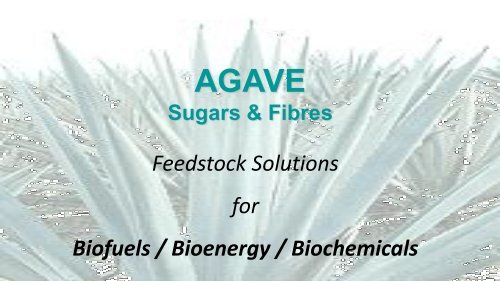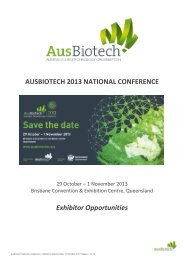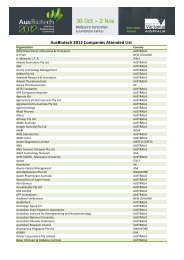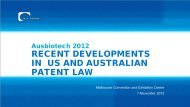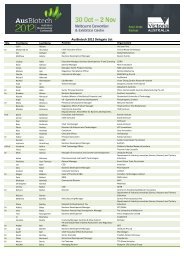Don Chambers - Ausbiotech National Conference
Don Chambers - Ausbiotech National Conference
Don Chambers - Ausbiotech National Conference
You also want an ePaper? Increase the reach of your titles
YUMPU automatically turns print PDFs into web optimized ePapers that Google loves.
AGAVE<br />
Sugars & Fibres<br />
Feedstock Solutions<br />
for<br />
Biofuels / Bioenergy / Biochemicals<br />
1
Commercial opportunity<br />
• Ethanol – world’s largest biofuel replacement of fossil fuels<br />
• Over 100 countries have an ethanol mandate<br />
• Global ethanol demand will outstrip supply through 2020<br />
• Supplement existing sugar cane production systems<br />
• New industries and technologies<br />
• Bio-energy<br />
• Bio-fuel<br />
• Bio-chemicals<br />
• Additional regional areas – Australia, Brazil and Asia<br />
Agave can provide sustainable feedstock for increased biofuel demand<br />
2
THE COMPANY<br />
3
Australian Agave Pty Ltd<br />
Specialist biomass business producing feed-stocks for biofuels<br />
• Company incorporated to commercialise agaves in Australia/Global<br />
• Trading as AusAgave<br />
• Developed IP and know-how in propagation, agronomy and cropping systems<br />
• Exclusive access to selected varieties – high sugar and fibre<br />
• Progressed mechanisation for harvesting, crushing and processing<br />
• Recognised for global leadership in producing low cost sugars<br />
4
Progress<br />
Tissue culture<br />
Plant nursery<br />
3YO Pilot scale plantation<br />
3 years agronomy & yield data<br />
5
Biomass (tons dry weight ha -1 )<br />
Further Progress<br />
Comparison of the accumulation of biomass by Agave tequilana in Jalisco, Mexico ,<br />
and northern Queensland, Australia (next to sugar cane).<br />
120<br />
100<br />
80<br />
Mexico<br />
60<br />
40<br />
AusAgave System<br />
Base System<br />
20<br />
0<br />
0 1 2 3 4 5 6 7<br />
Plant age (years)<br />
Sources of information<br />
Nobel PS, Valenzuela AG. 1987. Environmental responses and productivity of the CAM plant, Agave<br />
tequilana. Agricultural and Forest Meteorology 39 (4), 319-334.<br />
Ausagave Kalamia trial (JCU)<br />
6
THE OPPORTUNITY<br />
7
Its all about Sugar ......<br />
AGAVES (uh-gah-vay)<br />
– Sugar and fibre rich crops<br />
– Drought proof (CAM) perennials<br />
– Non-invasive<br />
– No pests or diseases in Australia<br />
8
Feedstock comparison<br />
Product / process Corn Sugarcane Agave<br />
Demand as food Very high High None<br />
Agricultural value of land Very high Very high None - medium<br />
Water requirements High Very high None - low<br />
Environmental impact<br />
(fertilisers-insecticides)<br />
Very high High None - low<br />
Sugars (and starch) 16% - 20% 10% - 14% 20% – 28%<br />
Ethanol yield L/ha/annum 3,000 6,000 10,000<br />
Years to first harvest 1 1 5
Current Feedstock demand<br />
Zhongfu –<br />
•40 ML ethanol<br />
NQBE –<br />
•60 ML ethanol<br />
MacKay Sugar –<br />
•60 ML ethanol<br />
•fibre to replace 30,000<br />
tonnes coal<br />
Sucrogen –<br />
•Extra 60 ML ethanol<br />
Current feedstocks in<br />
Australia are food or<br />
feed crops<br />
10
Agave agro-economics<br />
Harvest<br />
t/ha<br />
Revenue<br />
AUS$/ha<br />
Costs<br />
AUS$/ha<br />
Gross Margin<br />
AUS$/ha<br />
Cane 100 6,000 3,600 2,400<br />
Agave* 150 6,600 2,360 4,240<br />
* Annualised 5 year harvest system for 2 selections<br />
Current exchange rate AUS$1 = R$2 (approximately)<br />
Commercial Product Supply only (business model “A”)<br />
1,000 ha annual contract for sale of juice and fibre<br />
sale price juice $220/t and fibre $40/t<br />
Forecasts<br />
projected annual income $33 million at YR 5<br />
11
Financial Potential<br />
AgTrans independent economic assessment<br />
2,000 ha/year fully integrated bioenergy production model<br />
Based on a 5 year harvest cycle – annual rotation<br />
• Inputs: CAPEX $110 million, OPEX $7.5 million p.a.<br />
• Outputs per annum:<br />
– 100 ML ethanol<br />
– 200 GWh electricity<br />
• Investment analysis:<br />
– NPV $161 million<br />
– IRR 25%<br />
12
Commercialisation Strategy<br />
Pilot Scale<br />
Plots<br />
Demo Scale<br />
Commercial<br />
Scale<br />
• 1 hectare<br />
• Varieties<br />
• Yields<br />
• Agronomy<br />
• Product specification<br />
• 10 hectares<br />
• Harvesting/processing<br />
• Off-take agreements<br />
• First revenue<br />
• 1,000 hectare annual<br />
planting/harvesting<br />
• Supply juice & fibre<br />
• Profitability<br />
13
Pathway to Market<br />
Current Pilot<br />
Scale Plots<br />
Demo Scale<br />
Commercial<br />
Scale<br />
•Development Funding<br />
•Self-funded<br />
•RIRDC, BioSA grants<br />
•Series A Investment<br />
•Equity finance<br />
•Govt grants<br />
•Commercial Funding<br />
•Debt finance<br />
•Equity investment<br />
•Sales<br />
Company Start-up<br />
Feasibility data<br />
Off-take Contracts<br />
Scale-up Plan<br />
14
AusAgave Business Model<br />
A B C<br />
Product supplier<br />
• sugar & fibre<br />
• interest from major ethanol<br />
producers<br />
• 10 ha off-take agreement<br />
Service provider<br />
(franchise model)<br />
• service growers ($/t or $/ha)<br />
• interest established<br />
Plant licences<br />
• appoint agents to grow and<br />
sell plants<br />
• licensed for territory or field<br />
of use<br />
15
A – Commercial Product Supply<br />
• Basis of current business plan and financials<br />
• 1,000 ha/yr - 5,000 ha total<br />
• 5 year harvest cycle with leaf harvest at yr 2 and 3, complete plant at yr 5<br />
YR 0 YR 1 YR 2 YR 3 YR 4 YR 5 YR 6 YR 7 YR 8 YR 9<br />
1000 1000<br />
1000 1000<br />
1000 1000<br />
1000 1000<br />
1000 1000<br />
1,000 ha → 50 ML ethanol plus 100 GWh electricity / year<br />
16
B – Franchise Model<br />
• Business model in development – e.g Mackay Sugar Co-op<br />
• Real interest from ‘off-grid’<br />
– mining industry<br />
– isolated towns and regions<br />
– isolated industries requiring energy eg irrigation<br />
– existing grower groups<br />
• Will drive the adoption of numerous conversion technologies<br />
17
C – AusAgave licensing opportunity<br />
Brazil Government – EMBRAPA project cooperation; germplasm export label<br />
Minister Fernando Bezerra Coelho (Brazil) at Ayr site with <strong>Don</strong> <strong>Chambers</strong> on 26 August 2011<br />
18
MEMORANDUM OF UNDERSTANDING<br />
BETWEEN<br />
EMPRESA BRASILEIRA DE PESQUISA AGROPECUÁRIA (EMBRAPA)<br />
AND<br />
AUSTRALIAN AGAVE PTY LTD (AUSAGAVE)<br />
The Empresa Brasileira de Pesquisa Agropecuária, a public company within the scope of the federal government,<br />
under the Ministry of Agriculture, Livestock and Food Supply (MAPA) of the Federative Republic of Brazil, created by Law<br />
number 5.851, of 12 February 1972, as modified by Federal Law number 12.383, of March 1, 2011, with its current bylaws approved by<br />
Federal Decree nº 7.766, of June 25, 2012, , registered in the <strong>National</strong> Corporate Register (CNPJ) under nº 00.348.003/0001-10,<br />
with headquarters in Brasília, DF, at Parque Estação Biológica – PqEB s/n, final da Avenida W/3 Norte, hereinafter called<br />
EMBRAPA, represented in this MoU by its President Dr. Maurício Antônio Lopes;<br />
Australian Agave Pty Ltd, (ABN 93 153 149 734) Level 1, 214 Greenhill Road, Eastwood, South Australia 5063, Australia,<br />
hereinafter called AusAgave, represented in this MoU by its Managing Director Dr. <strong>Don</strong> <strong>Chambers</strong>;<br />
which in this MoU shall also be designated, individually, as the/a “Party” and, jointly, as the “Parties”, declare their mutual interest and will to start a cooperative program in the fields of<br />
agricultural research and technology with the aim of developing sustainable technologies, based on laboratory and field tests and assays with Agave tequilana Weber in a few Brazilian regional<br />
environments, with the final purpose of identifying and/or developing and introducing adapted Agave plants and cultivars, and the respective production system, apt to be used in the Brazilian<br />
production of ethanol.<br />
19
Next Steps<br />
Stage 1 Focus on Commercial Product Sales<br />
• obtain finance and resources for 10 ha demonstration site<br />
• build prototype machinery (planter, pruner, harvester)<br />
• 3 year old plants from Pilot characterised (proof of concept)<br />
• off-take agreements secured to enable commercial funding<br />
Stage 2 Expansion of Business Model<br />
• expand and build on stage 1 know-how<br />
• demonstration sites in NT, SA, WA, NSW<br />
• franchise agreements secured (township, mining, irrigation)<br />
• overseas R&D licensing/collaboration (Brazil Government)<br />
20
Investment Opportunity<br />
• Demo-scale operation - $1.8 million<br />
• Enables matching, non-dilutive Federal Govt grant (CA)<br />
• Investment will position AusAgave to:<br />
– secure off-take agreements<br />
– obtain debt financing of $25 million<br />
– set-up and operate commercial-scale facility to profitability<br />
Commercial scale ABF feedstock production generates<br />
revenues of $33 million per annum<br />
21
Thank you<br />
<strong>Don</strong> <strong>Chambers</strong><br />
Australian Agave Pty Ltd (AusAgave)<br />
22
Of all the new bio feedstock crops,<br />
agave is arguably the best prepared and closest to commercialisation and rapid<br />
scale-up<br />
AUSAGAVE IN BRAZIL<br />
23
Implementation Strategy<br />
Pilot Scale<br />
Plots<br />
EMBRAPA<br />
CODEVASF<br />
Demo Scale<br />
sugar cane<br />
supplement<br />
Commercial<br />
Scale<br />
• 10x5 hectare<br />
• Varieties<br />
• Yields<br />
• Agronomy<br />
• Product specification<br />
• 2x50 hectares<br />
• Harvesting/processing<br />
• Off-take agreements<br />
for supply of juice and<br />
fibre<br />
• ? Ha plant & harvest<br />
• Supply juice & fibre to<br />
existing operators<br />
• JV with Biofuel &<br />
Biochemical companies<br />
24
Next Steps in Brazil<br />
1 MOU with EMBRAPA<br />
• Extent of research vs development<br />
• Fast track with AusAgave in Australia<br />
• Funding & Resources<br />
2 Commercial Negotiations<br />
• identified 3 potential partners (sugar, A.sisal, bioplastics)<br />
• licence, strategic partnership, joint venture?<br />
• mechanisation (planter, pruner, harvester, separation)<br />
3 Business Models for Commercial Scale<br />
• existing sugar & ethanol industry<br />
• existing agave industry<br />
• biochemical industries<br />
25
SISAL PRODUCING COUNTRIES<br />
México ---<br />
El Salvador----<br />
--- Cuba<br />
--- Haiti<br />
--- China<br />
Venezuela ----<br />
--- Brasil<br />
--- Quênia<br />
--- Tanzânia<br />
--- Madagascar<br />
---------- Moçambique<br />
--- África do Sul
SISAL LEAF CONSTITUTION (W/W)<br />
‣ FIBER: 5%<br />
‣ MUCILAGE: 15%<br />
‣ JUICE: 80%<br />
LEAF DECORTICATING (W/W)<br />
FIBER: 4% (strings and other products)<br />
WASTE: 96% (usually wasted)<br />
- MUCILAGE: 15% (fertilising, feed)<br />
- SMALL FIBERS: 1% (special papers)<br />
- JUICE: 80% (potential products)
FIBER DRYING
SEPARATION OF WELL-DECORTICATED FIBERS AND<br />
BAD-DECORTICATED FIBERS
TRANSPORT TO INDUSTRY OR PORT
Spinner: twine production
Pallets ready for export


